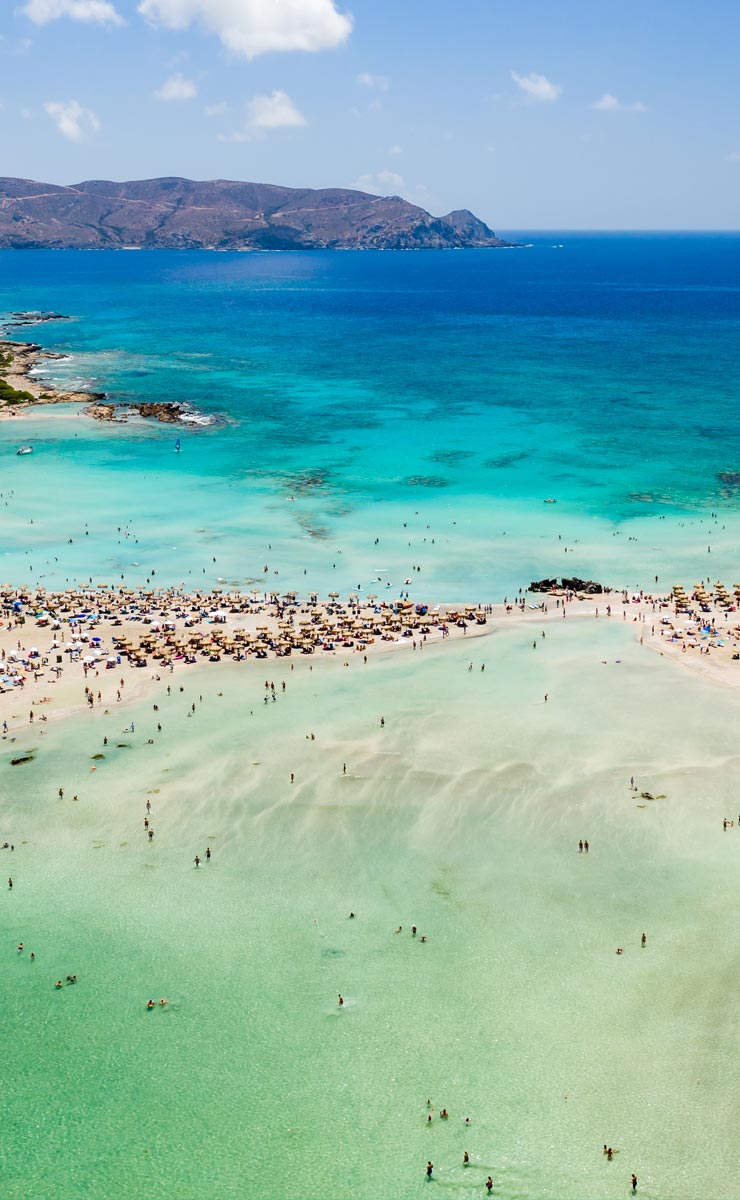No one knows why this place is named "Deer Island," which is what "Elafonisi" means, because there are no deer anywhere near. Neither is there a whole lot of vegetation to support deer. Neither is the island shaped like a deer. But what's interesting about Elafonisi, which is in the extreme southwest corner of Crete, about 75 km from Chania, is that the sand has a distinctly pink cast in places because of the addition of crushed seashells to its content.
Elafonisi was recently voted the best beach in Greece by visitors to the area. The entire area, including the beach on the mainland, is known as Elafonisi. The island itself, which is small, and uninhabited, by people or deer, is reachable in good weather by wading through the meter-deep, stunningly aquamarine water from the shore, which is a bit more organized with umbrellas for rent. There is also a lifeguard, a canteen or two for snacks with shaded tables and chairs, showers, a WC, and changing cabinets.
The waters around the island and the mainland are exceptionally shallow, with little sandbars and islets here and there, changing shape and location according to the tides. People enjoy playing games like volley and racquet ball right in the shallow, calm waters.
Elafonisi has been included in the Natura 2000 Protection Program, which is a network of nature protection areas in the European Union. It's goal is to protect the habitat of endangered species of all kinds. In this case Elafonisi is the habitat of the Caretta-Caretta sea turtle, with roped-off areas where the turtles lay their eggs.
What people say about Elafonisi, and what brings those day trippers in their thousands there every day during the summer is that it is like a lagoon in the South Pacific more than an island in Greece. Unfortunately, the sometimes large crowds can spoil that effect. Not to worry: if you have a little get up and go, you can wade over to the island (sometimes the sands arrange themselves in such a way as to create a sand bar you can walk across without getting your feet wet), and keep going until you find a deserted cove, and viola! Instant South Pacific vibe. Most people don't bother to go very far on the island, and even in the highest of high seasons a deserted beach all your own is easy to find.
At the highest point of the islet there is a plaque commemorating the Easter Sunday, 1824 massacre of several hundred Greeks, mostly women and children, by Ottoman Turk soldiers. The Greeks, among them 40 armed men, were hiding on the island, being pursued by the Turks, and waiting for a boat to take them to the Ionian Islands, then under Venetian control. The Ottomans were camping on the shore, when one of their horses waded across the channel to the island. The Greeks were discovered when Turkish soldiers went to fetch the horse. The approximately 700 Greeks hiding on the island were either killed or sold into slavery in Egypt.
There was also a shipwreck nearby, in 1907. An Austrian passenger steamer foundered off the coast, and 38 people died when their lifeboat sunk offshore. All 38 are buried on Elafonisi.
About 5 km north of Elafonisi is the Monastery of Chrisoskalitissa. A compact little cluster of buildings built on a rocky outcrop, it's worth a visit. The name means "golden step," and the tradition is that the name came from the fact that the final of the 98 steps leading up to the monastery was made of gold.
Despite its relatively remote location, Elafonisi is daily visited by up to 2,500 people during July and August. There are some accommodations not too far away, but most people come there as a day trip, usually from Chania, which is about an hour away.












